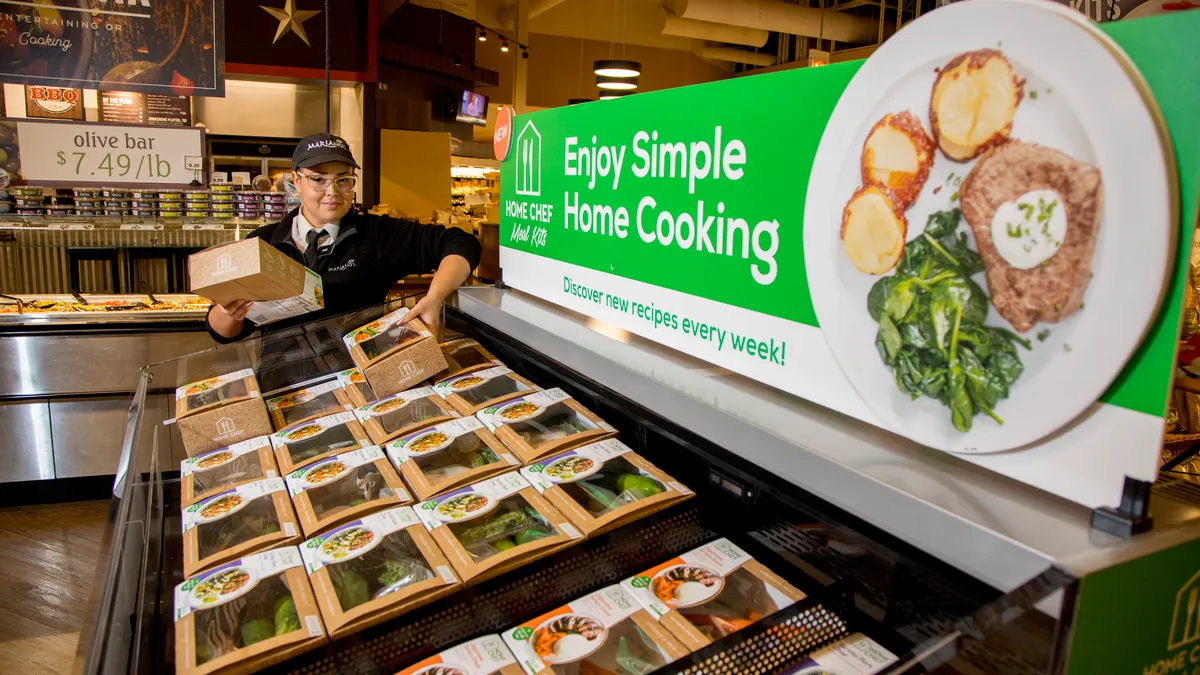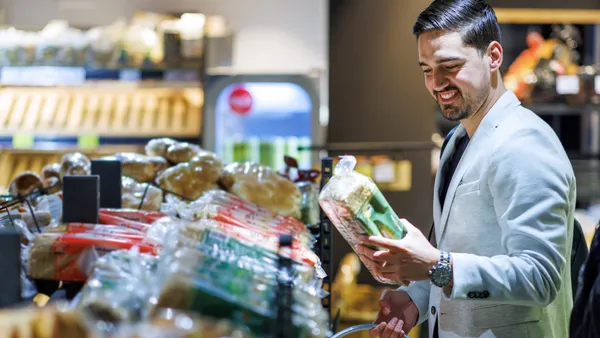Dive Brief:
-
Meal kit sales are surging as efforts to curb the spread of COVID-19 crimps people’s ability to dine out. Meal kit providers like Blue Apron, Sun Basket, Gobble and Home Chef are expanding their operations and adjusting their offerings to meet growing demand, and revenue for the sector has almost doubled year-over-year after sinking earlier in 2020, according to The Wall Street Journal.
-
Germany-based meal kit company HelloFresh nearly doubled its U.S. customer count to 2.6 million in the first quarter of 2020 compared to the same period in 2019, while its overall quarterly earnings swung from a loss last year to nearly $70 million during the same period this year, according to its quarterly report, released Tuesday. Meanwhile, the number of customers buying from Kroger-owned Home Chef is up by almost three times during the past six weeks, WSJ reported, and the company is using facilities run by the grocery chain that ordinarily supply meals for airlines.
-
Restaurants are stepping into the meal kit sector to tap consumer interest in spicing up their meal options while people are stuck at home. Chick-fil-A began selling chicken-based meal kits this week at drive-through locations and through delivery services like DoorDash, Uber Eats and Grub Hub. Denny’s is hoping to attract customers with kits that allow them to prepare pancake breakfasts, sandwiches and other menu items at home, according to Restaurant Business.
Dive Insight:
The pandemic-driven cabin fever that has gripped people across the country since March may be just what meal kit companies need to rekindle their businesses. Even as consumers unable to dine out have loaded up on essentials, they have demonstrated that they want to hold onto at least part of the convenience and enjoyment that comes from easy-prep and restaurant-style meals.
Although meal kit suppliers have struggled to maintain customer loyalty in recent years, the changing market dynamics caused by the pandemic may be cause for grocers that haven’t entered the meal kit fray to look again. Blue Apron, which saw its stock price surge in March as investors saw new promise in the meal-kit business, reported that sales were up 8% in the first quarter of 2020 even as the firm posted a $20.1 million loss. The company recorded nearly 2.5 million orders during the period, up from 1.6 million during the first three months of 2019. Some 550,000 customers bought meal kits from Blue Apron during between January and March, compared with 351,000 during that timeframe last year.
HelloFresh grew its U.S. customer base from 1.4 million in last year's Q1 to 2.6 million this year while overall sales increased 66.4% to more than $700 million. The company, which sells retail-ready kits to chains like Giant Food, projects higher earnings for the year, and adjusted its revenue growth projection from around 25% to between 40% and 55%.
The question for supermarkets is whether this high demand will last or not. Meal kits have already been through a boom-and-bust cycle, with many shoppers dropping subscription services after just a few months. Store kits also have failed to catch on so far, but retailers and kit companies are retooling their offerings to focus more on quick-prep and grab-and-go style meals. Albertsons pulled its Plated meal kits out of stores last year and is now re-releasing them with new branding and meal options.
Blue Apron CEO Linda Findley Kozlowski, for one, believes the shift in how and what people eat will be around for the long haul.
“As we move into the second quarter of 2020, we are focused on driving customer retention and establishing longer-term consumer habits out of the heightened demand we have been seeing as a result of the impact of COVID-19, including stay-at-home and restaurant restriction orders and other changes. Given this, we expect that this uptick in demand can be maintained beyond the period of direct impact of COVID-19, even as restrictions begin to be lifted,“ Kozlowski said in an April 29 statement.
Another factor for supermarkets to consider is that the pandemic has further blurred the lines that have traditionally separated grocery stores from dining establishments. Restaurant operators like Panera and Subway, which have been forced to innovate to keep at least some business coming in as stay-at-home orders shuttered their dining rooms, are now selling groceries, allowing them to position themselves as places for people to stock up on food to keep at home, which is new ground for these companies. Those moves could spur grocers to turn more resources toward offering customers the ability to take home a restaurant-like experience when they go to the store for ingredients to cook themselves.













